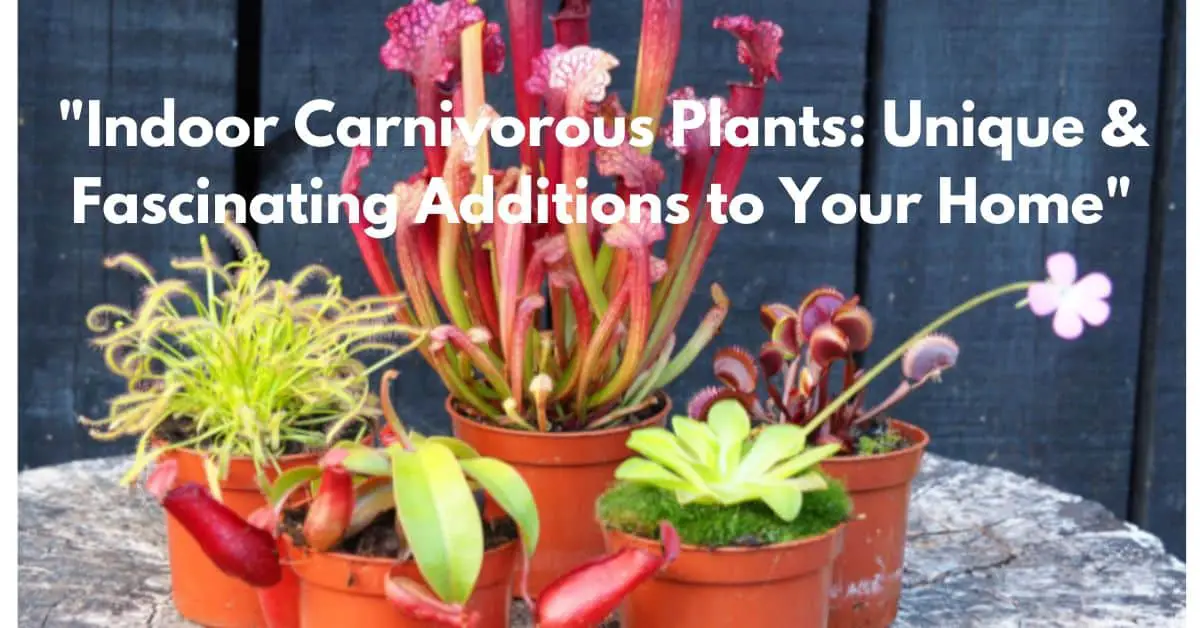Indoor carnivorous plants aren’t just unique; they’re conversation starters. These plants are known for their ability to catch and digest insects, and they’re perfect for plant lovers who want something a little outside the norm. With the right setup, you can create a mini habitat that highlights the beauty and intrigue of these fascinating plants.
Whether you’re drawn to the iconic Venus flytrap or the elegant Nepenthes (pitcher plant), there’s something captivating about a plant that doubles as a natural pest control system!
Table of Contents
Why Choose Indoor Carnivorous Plants?
One of the best aspects of indoor carnivorous plants is their unique look and function. Their vibrant colors, distinctive shapes, and insect-eating abilities make them perfect for anyone looking to create a focal point. Additionally, they add practical benefits by catching and digesting small insects.
Indoor carnivorous plants come in a wide range of varieties, each offering a unique aesthetic and insect-trapping technique. Whether you live in a small apartment or a house with lots of windows, there’s likely a species that will thrive indoors with a bit of extra care.
Top Indoor Carnivorous Plants for Your Home
- Venus Flytrap (Dionaea muscipula)
- This classic carnivorous plant is famous for its snap-trap mechanism. With its spiky-edged “jaws” and quick response to prey, the Venus flytrap is a favourite for beginners and experienced plant owners alike.
- Care Tip: Keep the soil moist, use distilled water, and provide bright, indirect light.
- Pitcher Plant (Nepenthes)
- Pitcher plants have tubular leaves that fill with digestive liquid, luring insects in and trapping them. They’re visually stunning and have a unique, exotic look.
- Care Tip: They enjoy humidity and indirect light. Mist them regularly or place them near a humidifier to replicate their natural tropical environment.
- Butterwort (Pinguicula)
- Butterworts have flat, sticky leaves that attract and catch insects. They’re also easy to grow and add a splash of green and texture to any indoor setup.
- Care Tip: Keep them in well-draining, sandy soil. They appreciate regular watering, but avoid letting their roots sit in water for too long.
- Sundew (Drosera)
- Sundews have tentacle-like structures covered in sticky dew, which attracts insects and traps them. They add a whimsical look to any indoor garden.
- Care Tip: Sundews do well in bright light and require consistently moist soil. Like other carnivorous plants, they need distilled or rainwater.
Setting Up the Ideal Environment for Indoor Carnivorous Plants
Carnivorous plants evolved in environments with specific conditions, so replicating those as closely as possible will help your plants thrive indoors. Here’s what they need:
- Watering: Most carnivorous plants prefer distilled or rainwater. Tap water contains minerals that can harm them, so aim to use only purified water.
- Soil: A nutrient-poor, acidic soil mix is essential. Regular potting soil doesn’t work for these plants. Instead, use a mix of sphagnum peat moss and perlite.
- Light: Bright but indirect light is ideal for most carnivorous plants. A spot near a sunny window can be great, but avoid direct sunlight that might scorch their leaves.
- Humidity: Many carnivorous plants, like Nepenthes, appreciate higher humidity. Consider using a humidifier, especially in drier climates.
Real-Life Experiences with Carnivorous Plants
I added a Venus flytrap to my indoor collection last year, and it’s been an adventure! Watching it snap shut when it catches an unsuspecting fly is endlessly fascinating. My guests are always amazed, especially kids who can’t believe a plant could “move.”
One tip I’d offer is to avoid overfeeding your carnivorous plants. If you don’t have many insects in your home, resist the temptation to feed them too often. Indoor carnivorous plants don’t need frequent feeding and can actually suffer if overfed.
Quick Tips for Maintaining Healthy Indoor Carnivorous Plants
- Avoid Fertilizers: Carnivorous plants get nutrients from their insect prey, so avoid adding fertilizer to their soil. Fertilizer can actually harm them.
- Monitor for Pests: While they catch insects, indoor carnivorous plants are still susceptible to pests like aphids. Use natural pest control if necessary.
- Repot with Care: Carnivorous plants don’t need frequent repotting, but if they outgrow their container, carefully transplant them with fresh, appropriate soil.
- Stay Patient: Carnivorous plants have slower growth compared to some other houseplants, so patience is key.
A Unique Addition to Indoor Vertical Gardens
Indoor carnivorous plants work exceptionally well in vertical gardening setups. You can create a hanging arrangement or a wall-mounted display using small containers or shelves to showcase their unique shapes. Mixing them with other humidity-loving plants like ferns or mosses can help create a thriving mini-ecosystem.
Conclusion
Adding indoor carnivorous plants to your collection brings an element of fascination and functionality to your home. They offer natural pest control and are captivating in their own right. With the right care, indoor carnivorous plants like the Venus flytrap, pitcher plant, and sundew can thrive in your indoor space, making them a unique addition to any plant enthusiast’s collection.
If you’re ready to bring a little bit of nature’s wild side into your home, consider starting with one of these fascinating plants. Not only will they give your indoor garden an exotic feel, but they’ll also keep it free of pesky insects.










